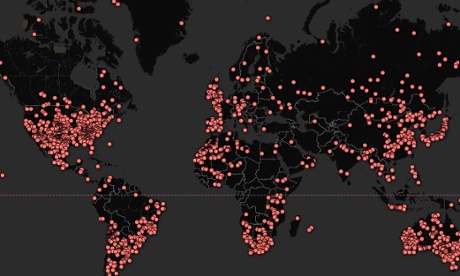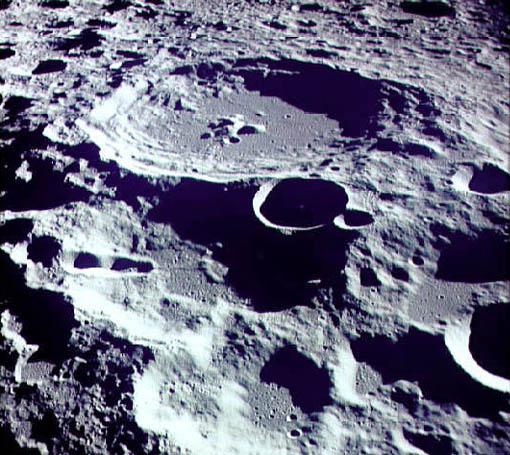General Discussion
Related: Editorials & Other Articles, Issue Forums, Alliance Forums, Region ForumsEvery meteorite fall on earth mapped
So my question is: when planning one's next relocation, would you move to the areas that have no or few hits, or an area that has many, figuring that statistically it'd be less likely to be hit again? Is there some logic to the patterns, or is it just a function of population and the liklihood of either having been witnessed or recovered? Why the clustering? Why some areas with no hits whatsoever? What do you think?
http://www.guardian.co.uk/news/datablog/interactive/2013/feb/15/meteorite-fall-map

jberryhill
(62,444 posts)First of, it is not a map of "every meteorite fall".
It is a map of "those we know about", where "we" is not defined. English speaking people who report meteor falls?
Well, let's see - none "fall" in the ocean, none "fall" in vast stretches of uninhabited land like the Sahara. A lot fall in agricultural plain areas where people work outside a lot.
Do you see some sort of pattern of craters on the moon? Why, or why not? If there was some sort of pattern to earth impacts, would you expect to see the same, or a different pattern on the moon?
Edit: I see that "we" is defined as "data from the US Meteorological Society". Looking at Brazil, I see they have few members among Amazonian tribes.
DreamGypsy
(2,252 posts)...an essentially uniform density of meteorite falls over the entire surface of the earth. Most of them are small, but the locations where big ones strike are random.
The data used to generate the map is available here: https://www.google.com/fusiontables/DataSource?docid=1vHSvjNgCIl6kRhFXPHhvESnnYx_ShToJWtWdjm8#rows:id=1
wandy
(3,539 posts)If a meteorite falls in the forest and no one is their to see it, does it make a dot on the map?
onehandle
(51,122 posts)
laundry_queen
(8,646 posts)and are therefore more likely to report suspected meteorites. When you have no one see the streak in the sky, it's just not going to get reported. If a big streak goes over a city of a few million, lots of people are going to notice. Hence the reports are clustered around populated areas.
Duer 157099
(17,742 posts)It seems to be based more on finding evidence rather than eyewitness reports.
laundry_queen
(8,646 posts)there are more likely to be examinations done by more people close to populations centres. You don't have hundreds of scientists travelling to the vastness that is the middle of Russia to search for possible impact craters or old meteorites in a field. However, you probably have a dozen or so looking around each major city in the world. And the countries with the most scientists probably have more discoveries. It's also possible, if you look at Australia, that the terrain of the area plays some role. In some areas, if the terrain isn't changing rapidly, as in a desert, and meteorite sites or craters aren't getting eroded or covered over, you are going to have a lot more discoveries, than, say, in a forested, or swampy area.
Duer 157099
(17,742 posts)that great big hole in the center of France. Is that unpopulated? I agree that population density will correlate to some degree, but a complete absence in large areas, with multiple hits nearby? Is it totally correlated with population?
laundry_queen
(8,646 posts)I'm not familiar with terrain in France. And I'm not a scientist either, just someone who used to read a lot of space and science books and I was just thinking outloud.
I'm not sure what you are trying to imply. Do you want me to tell you, "Yes, there are places on the earth that are more likely to be hit than others so if you want to save yourself move to the places that don't have dots on them?" ![]()
Duer 157099
(17,742 posts)Nothing more, nothing less. All is well. ![]()
laundry_queen
(8,646 posts)just wasn't sure what you were trying to get at or why I felt singled out, lol. Take care.
DreamGypsy
(2,252 posts)...is probably the Alps. Some difficult terrain for searching.
Also, apparently not a lot of people spend time looking for meteorite evidence in the Amazon basin.
etc.
(on edit: it's hole in the middle of France, not a whole. sheez, idiot ![]() )
)
Tommy_Carcetti
(43,198 posts)There are only 100 or so documented reports of shark bites every year, a large amount of those off the coast of the US. But there may be many more undocumented shark bites in areas where it is not common to report such bites.
Voice for Peace
(13,141 posts)whopis01
(3,523 posts)Brother Buzz
(36,463 posts)Duer 157099
(17,742 posts)Robb
(39,665 posts)LiberalFighter
(51,084 posts)DisgustipatedinCA
(12,530 posts)slackmaster
(60,567 posts)Or at the North Pole.
Retrograde
(10,156 posts)I think I'll take my chances with the meteors!
slackmaster
(60,567 posts)You are much more likely to be injured or killed in a motor vehicle accident than anything else. Keep your eyes on the road when you drive, and watch out for clowns who are texting or otherwise distracted.
The second most likely type of incident to injure or kill you is poisoning, followed by slip and fall accidents.
You are far more likely to be struck by lightning than by a meteorite. Stay out of Florida.
Duer 157099
(17,742 posts)If one were a meteorite hunter.
slackmaster
(60,567 posts)I like them a lot.
jberryhill
(62,444 posts)If you want to find meteorites, it is more important to go somewhere where they will most easily be found. That will bear no relationship to where they most frequently strike - even if they did strike more frequently in one place than another.
For example, let's say that meteors were more likely to fall in the Okefenokee swamp than an area the same size on the Great Plains.
Where will you be most likely to find them?
The answer is not in the swamp, because you will not find them in the swamp. This was one of the frustrations of the various expeditions which attempted to find an object associated with the Tunguska event. The area is a great big bog.
A fantastic place where it is very easy to find meteorites are ice-covered plains of Antarctica. It is dead bang simple, since any rock on top of the ice didn't come up from underneath it, and thus must have come from above. You don't need a metal detector or any other analysis equipment or skill. Any rock you find on top of a thousand feet of ice is a meteorite. This is also why sand dunes are a good place to look.
You don't find frequent reports of finding them there (although a lot of them are, indeed, found there), because there aren't a whole lot of people hanging around in Antarctica.
But the notion that there is any place on earth more likely to get hit than another is a facially difficult hypothesis, given that they can come from any direction at any time, and the earth spins. It's like asking whether a bullet shot at a tire of a moving car is more or less likely to hit near the brand name of the tire. Earth features have no relationship to the mechanism by which meteors approach the earth. Even if you go for exotic mechanisms like induced currents in metallic rocks interacting with the earth's magnetic field on the way in, or magnetic rocks directly interacting with the earth's magnetic field, the forces involved are going to have zero influence on the momentum of the rock. Likewise, local magnetic or gravitational anomalies are "anomalous" to a very small degree, which will have utterly no effect on a rock coming in at a couple hundred miles per hour. It's like asking whether hitting a fly slows down a race car.
Voice for Peace
(13,141 posts)what would possibly cause such a phenomenon?
JVS
(61,935 posts)Especially when compared to the American West.
LondonReign2
(5,213 posts)with the effectiveness of Canada's ballistic shield
Sheepshank
(12,504 posts)is that the equator, or Tropic of Capricorn? Seems meteors are not seen very often along that line.
Interesting so many meteors are found inland in Australia. Populations and cities are costal.
jberryhill
(62,444 posts)Last edited Fri Feb 15, 2013, 05:43 PM - Edit history (1)
As noted above, the terrain is an important factor in where you are going to find meteorites.
The interior of Australia is arid. Arid sandy places are good places to look, since rocks don't walk up sand dunes. Therefore, when you find a rock on top of sand, there is a good likelihood it had to come from somewhere above the sand.
The map also includes craters. Central Australia has been a big flat dry place for a long time, and hence there is less erosion of craters.
The moon is pock marked with craters because (a) there is no atmosphere to burn off meteors and (c) there is no weather to erode craters.
MrScorpio
(73,631 posts)
jberryhill
(62,444 posts)Is that the data includes where meteorites were found AND where craters are found.
Okay. Now. if we were looking for meteor craters, would we find more in Hawaii, or in a comparable area of central Australia?
The answer is Australia. Why? It's been around longer - a lot longer.
It's kind of like looking at where people have found dinosaur fossils, and concluding from that map where there were more dinosaurs.
That is the same error. You find dinosaur fossils in abundance in some places due to the fact that there were conditions for forming fossils in the first place, and these conditions preserved them in such a way that we can find them. The actual distribution of dinosaurs had little to do with the present distribution of findable dinosaur fossils.
DeadEyeDyck
(1,504 posts)belt is on plain with the earth's equator, roughly speaking. I would recommend the North, since the other one gets a little nippy.